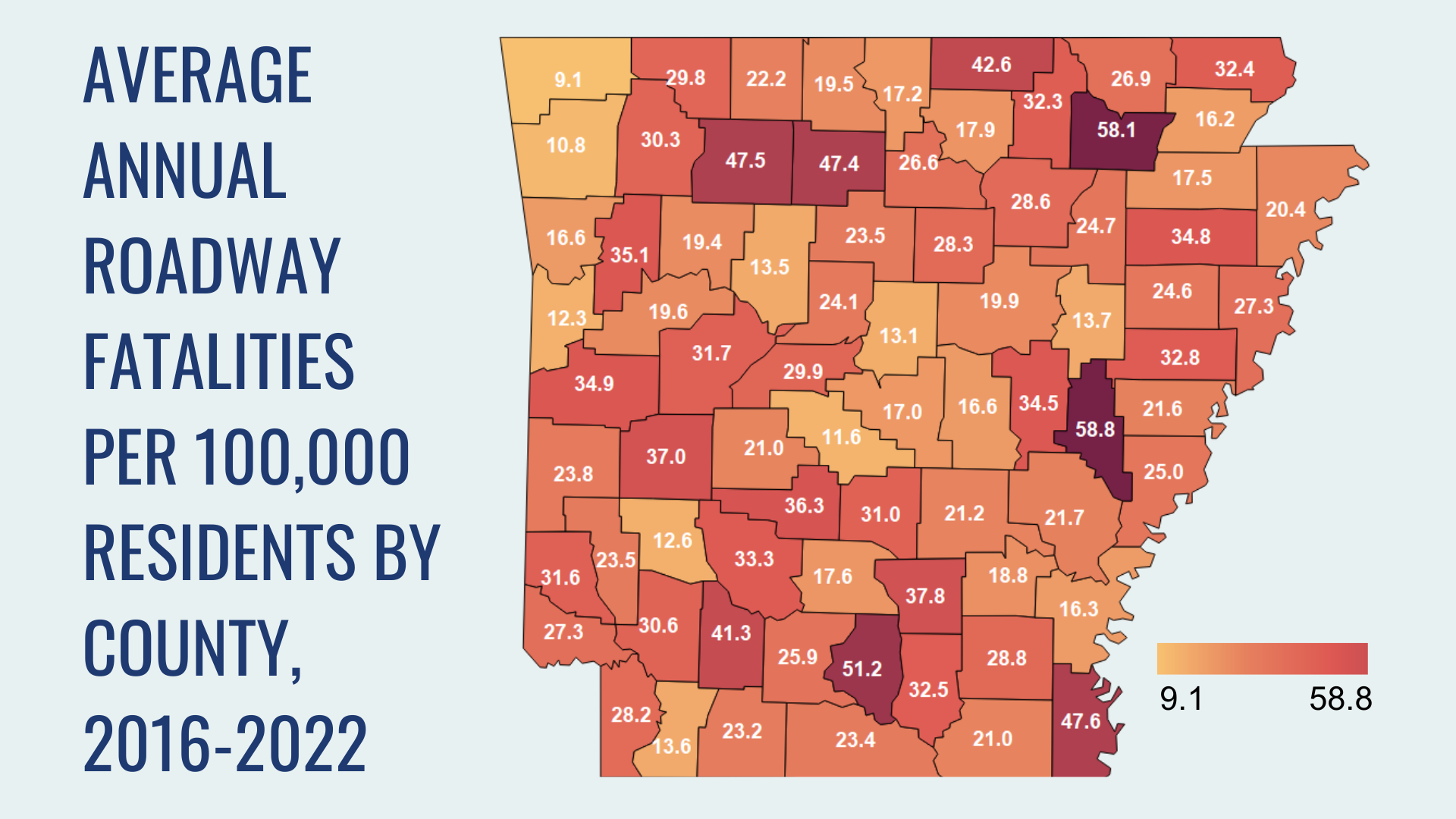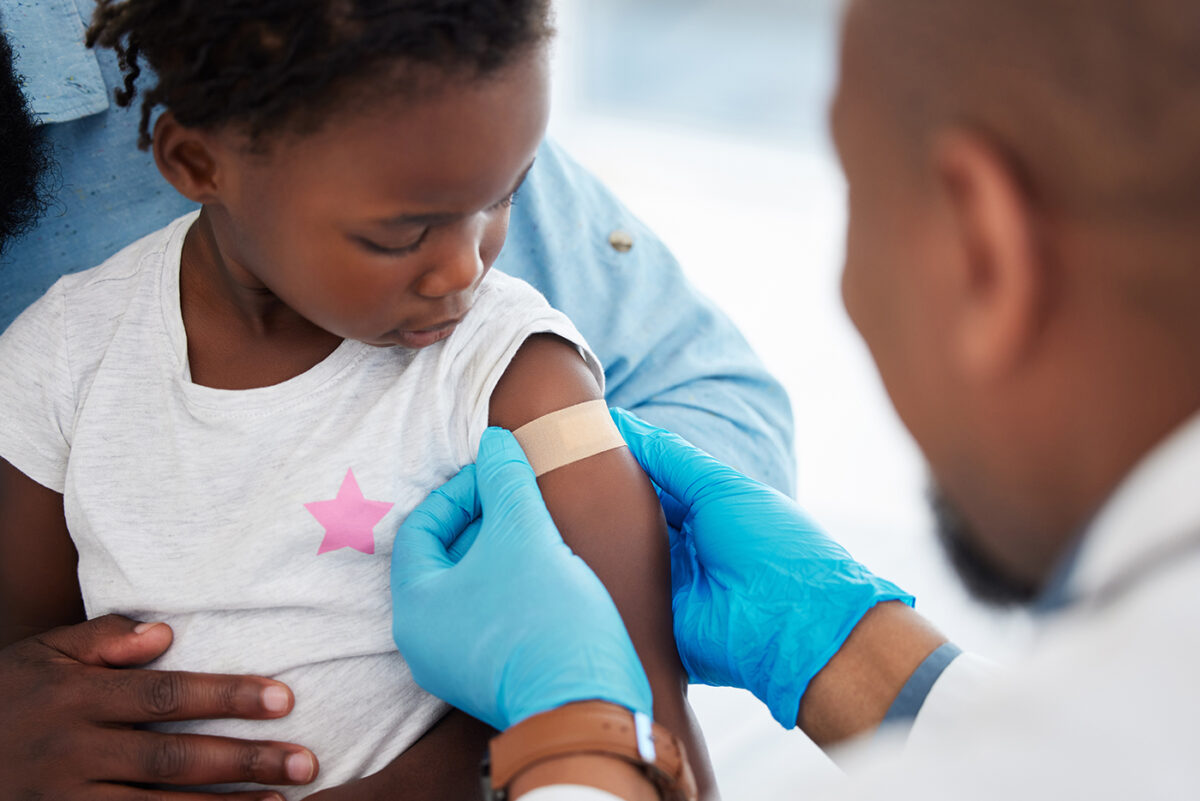
Author
Elizabeth (Izzy) Montgomery, MPA
Policy Analyst
Contact
ACHI Communications
501-526-2244
jlyon@achi.net
In 2022, Arkansas had the fourth-highest roadway fatality rate among the 50 states and the District of Columbia, with 21.1 deaths per 100,000 people.
This is one of the key takeaways from an analysis of roadway fatality statistics conducted by ACHI in support of safety efforts by the Arkansas State Police’s Highway Safety Office. This post highlights that and other findings from our analysis, which used data from the National Highway Traffic Safety Administration’s Fatality Analysis Reporting System for 2016 through 2022. As part of our Data Watch series, ACHI also published an infographic depicting notable findings.
Roadway Fatality Trends and Geography
Between 2016 and 2022, there were 4,089 roadway fatalities in Arkansas. On the map below, dots indicate locations of fatalities, with darker areas indicating multiple fatalities during the study period.

Arkansas experienced a significant increase in roadway fatalities during the COVID-19 pandemic. The state had 16.9 roadway fatalities per 100,000 people in the pre-pandemic year of 2019, but by 2021 the rate had climbed to 22.9 fatalities per 100,000 people. While the rate decreased to 21.1 fatalities per 100,000 people in 2022, this was still higher than pre-pandemic levels.
Our analysis also found that rural counties were disproportionately affected by roadway fatalities. The 10 Arkansas counties with the highest average annual roadway fatality rates per 100,000 residents during the period of study were all rural counties. They were:
- Monroe: 58.8
- Lawrence: 58.1
- Calhoun: 51.2
- Chicot: 47.6
- Newton: 47.5
- Searcy: 47.4
- Fulton: 42.6
- Nevada: 41.3
- Cleveland: 37.8
- Montgomery: 37

Fatality Demographics
Seventy percent of the 4,089 fatality victims (2,865) were male and 30% (1,222) were female (data for two fatalities did not include the sex of the victims). The age group that experienced the highest number of roadway fatalities was adults 65 and older with 745, followed by adults ages 25-34 with 714.
A comparison of different types of roadway fatalities found that motorists were the most affected group, comprising 75% (3,072) of all roadway fatalities. They were followed by motorcyclists at 13% (522 fatalities), pedestrians at 11% (459 fatalities), and bicyclists at 1% (36 fatalities).
A comparison of roadway fatalities by race and ethnicity shows that Black individuals represented a disproportionate number of fatalities relative to their population size. While only about 15% of the state’s total population is Black, nearly a third (31%) of all pedestrians who died in roadway accidents were Black. This is consistent with other analyses, including a 2022 study which found that Black pedestrians were more than twice as likely to be killed than White pedestrians.
Risky Behaviors
Several risky behaviors have been identified as major contributors to roadway fatalities. Our analysis found that 50% of motorist fatalities involved vehicle occupants who were not using restraints, while in 40% of those fatalities a restraint was used and in 10% restraint use was unknown. Speeding was associated with 20% of all roadway fatalities, although in a significant percentage (41%) of roadway fatalities it was unknown whether speeding was a contributing factor. In 39% of fatalities, speeding was not involved. We also found that more than half (57%) of motorcycle occupants killed in roadway accidents were not using a helmet, compared to 40% who did use a helmet. Helmet use was unknown for 3% of motorcycle occupants killed.
Efforts to Increase Roadway Safety
The findings from this analysis highlight several areas in which improvements can be made in roadway safety in Arkansas. Addressing the prevalence of risky behaviors, enhancing vehicle and road safety, and promoting adherence to safety measures are all crucial for reducing roadway fatalities.
Several efforts are underway. The Arkansas Department of Transportation, the Arkansas State Police’s Highway Safety Office, and other partners have developed the 2022-2027 Strategic Highway Safety Plan. The plan identifies specific goals, objectives, and strategies for reducing fatalities and serious injuries on public roads.
Earlier this month, the Arkansas Highway Safety Office launched a new public awareness campaign called “Extreme Safety” to enhance pedestrian and bicycle safety on Arkansas roadways. For motorists, the campaign emphasizes the importance of avoiding distractions, obeying speed limits and exercising caution at pedestrian crosswalks. For cyclists, the campaign encourages the use of helmets, checking bicycle brakes, and following the rules of the road. Finally, the campaign reminds pedestrians to use sidewalks and cross at designated areas.
On Sept. 5, the U.S. Department of Transportation announced that the city of Little Rock will receive $25 million in funding from the federal Safe Streets and Roads for All (SS4A) program. The Bipartisan Infrastructure Law established the SS4A program with $5 billion to be appropriated over five years (2022 through 2026). The funds will go directly to communities and are intended to improve roadway safety and prevent deaths and serious injuries on rural and urban roadways. The City of Little Rock will leverage funding to make improvements to five major corridors along its high-injury network. Examples of the types of projects planned include development of medians, creation of dedicated left- and right-turn lanes at intersections, and lighting enhancements. Nine other cities and counties in Arkansas are also recipients of SS4A grants, including the cities of Springdale and Batesville.
ACHI Health Policy Director Craig Wilson recently interviewed Dr. John Landosky, Little Rock’s bicycle and pedestrian coordinator, on our Wonks at Work podcast. The pair discussed efforts to implement the Central Arkansas Safety Action Plan, which was approved by the Little Rock City Board in May. Regional leaders have set a goal of achieving a 40% reduction in fatal and serious injuries by 2040, with interim goals established in five-year increments from 2025 through 2050. By 2050, the goal is to reach an 80% reduction in fatal and serious injuries on Arkansas roadways.






